Exploring Spatiotemporal Characteristics and Driving Forces of Straw Burning in Hunan Province, China, from 2010 to 2020
Abstract
:1. Introduction
2. Materials and Methods
2.1. Study Area and Straw Burning Data
2.2. Kernel Density Estimation
2.3. Geographically Weighted Regression Models
3. Results
3.1. Temporal Variations of Straw Burning in Hunan Province
3.2. Spatial Distribution of Straw Burning
3.3. Spatial and Temporal Variations of Driving Forces
3.3.1. Annual Change Rate
3.3.2. Geographical Variability Test and Model Evaluation
3.3.3. Spatially Heterogeneous Effects Analysis
4. Discussion
5. Conclusions
Author Contributions
Funding
Data Availability Statement
Acknowledgments
Conflicts of Interest
Appendix A
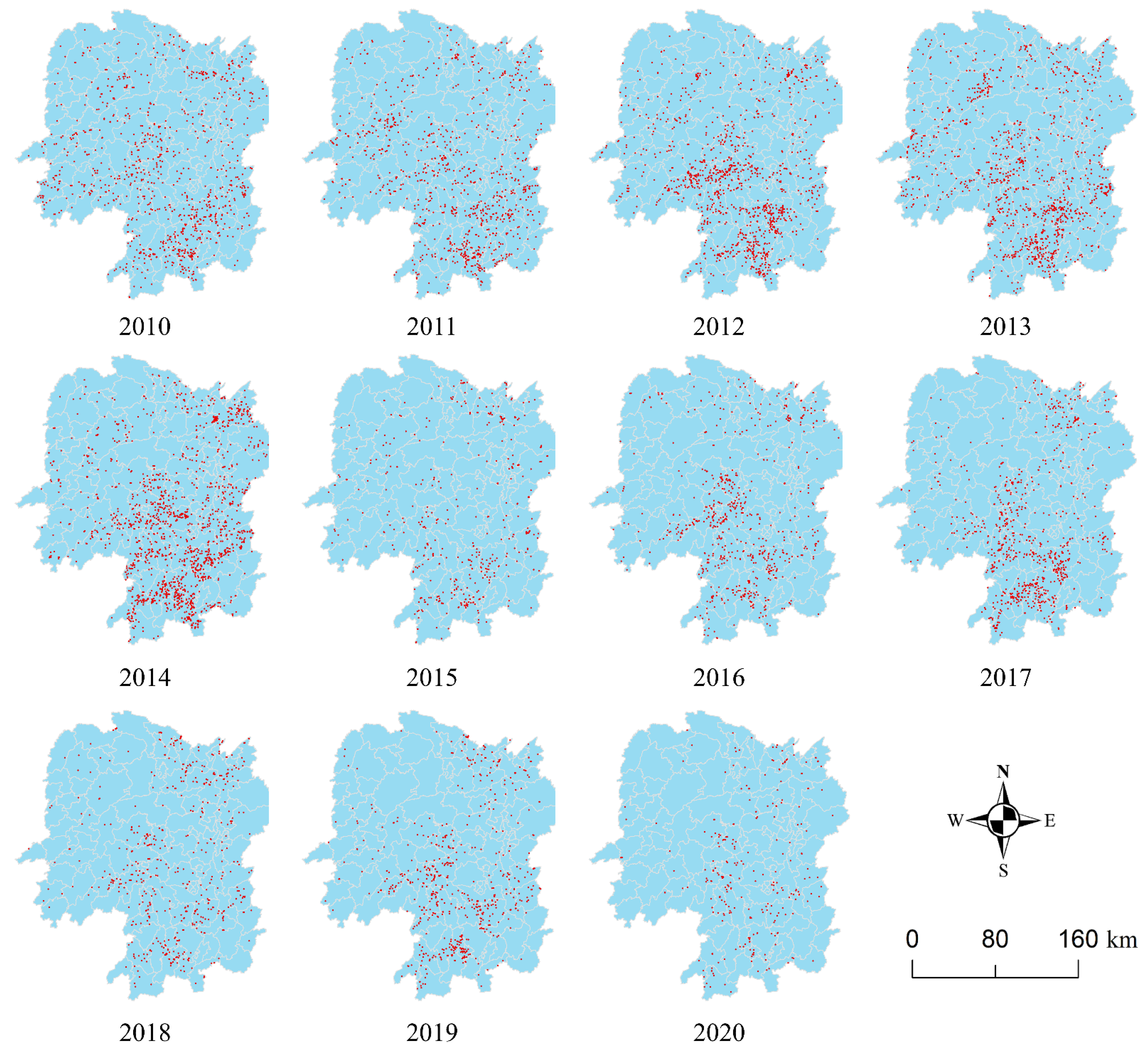



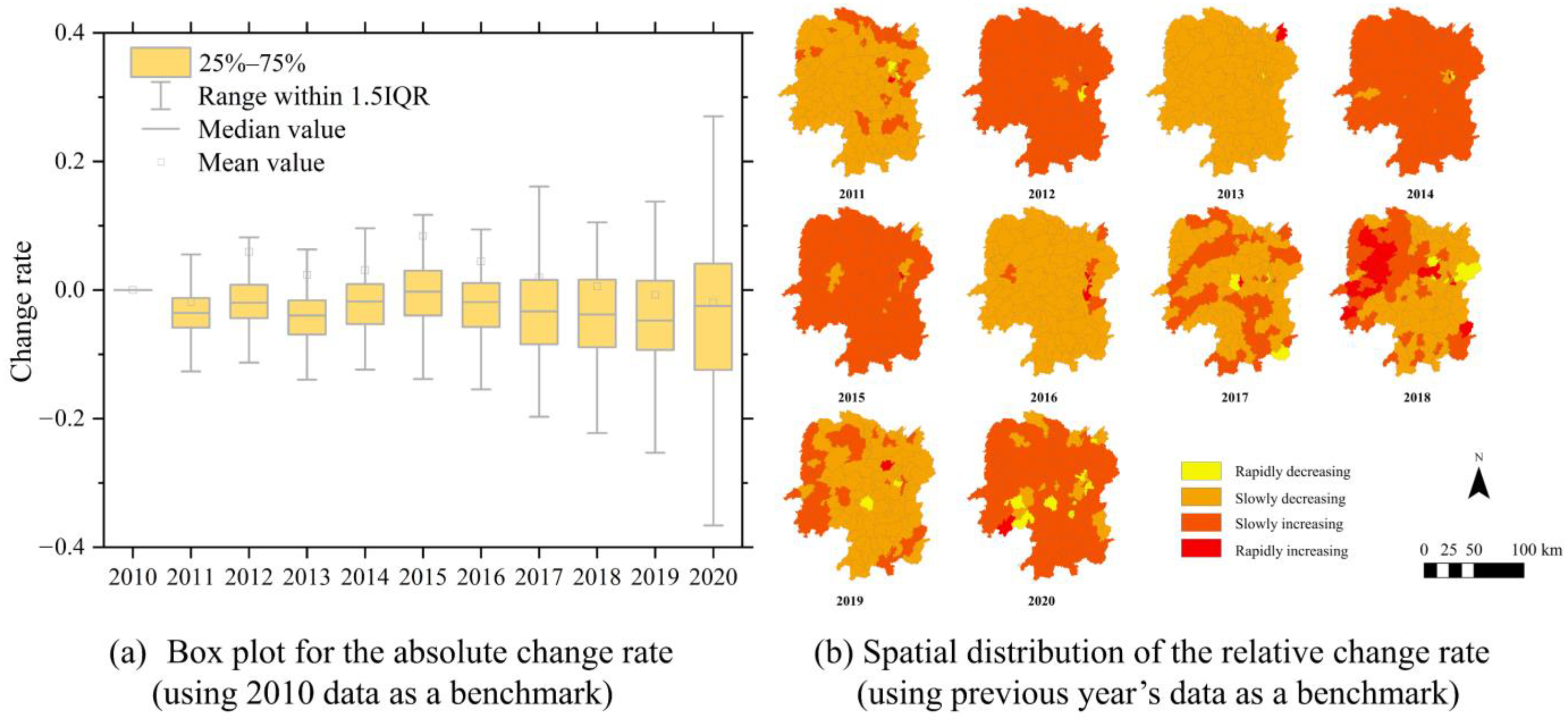
| Variable | Model 1 (2010–2014) | Model 2 (2015–2020) |
|---|---|---|
| Natural factors | ||
| Elevation | 7.488 | 6.118 |
| Slope | 12.819 | 10.902 |
| Aspect | 1.313 | 1.314 |
| Socioeconomic factors | ||
| Crop yield | 7.000 | 8.412 |
| Crop-sown area | 13.566 | 19.009 |
| Population density | 3.947 | 2.961 |
| GDP | 1.621 | 1.924 |
| Human activity factors | ||
| Road density | 2.957 | 2.442 |
| Settlement density | 2.015 | 2.947 |
| Distance from road | 1.656 | 1.274 |
References
- Rohde, R.A.; Muller, R.A. Air pollution in China: Mapping of concentrations and sources. PLoS ONE 2015, 10, e0135749. [Google Scholar] [CrossRef]
- Yang, G.; Wang, Y.; Zeng, Y.; Gao, G.F.; Liang, X.; Zhou, M.; Wan, X.; Yu, S.; Jiang, Y.; Naghavi, M. Rapid health transition in China, 1990–2010: Findings from the Global Burden of Disease Study 2010. Lancet 2013, 381, 1987–2015. [Google Scholar] [CrossRef]
- Li, H.; Wang, Q.G.; Yang, M.; Li, F.; Wang, J.; Sun, Y.; Wang, C.; Wu, H.; Qian, X. Chemical characterization and source apportionment of PM2. 5 aerosols in a megacity of Southeast China. Atmos. Res. 2016, 181, 288–299. [Google Scholar] [CrossRef]
- Tao, J.; Zhang, L.; Ho, K.; Zhang, R.; Lin, Z.; Zhang, Z.; Lin, M.; Cao, J.; Liu, S.; Wang, G. Impact of PM2. 5 chemical compositions on aerosol light scattering in Guangzhou—The largest megacity in South China. Atmos. Res. 2014, 135, 48–58. [Google Scholar] [CrossRef]
- Tao, J.; Gao, J.; Zhang, L.; Wang, H.; Qiu, X.; Zhang, Z.; Wu, Y.; Chai, F.; Wang, S. Chemical and optical characteristics of atmospheric aerosols in Beijing during the Asia-Pacific Economic Cooperation China 2014. Atmos. Environ. 2016, 144, 8–16. [Google Scholar] [CrossRef]
- Zhao, H.; Yang, G.; Tong, D.Q.; Zhang, X.; Xiu, A.; Zhang, S. Interannual and seasonal variability of greenhouse gases and aerosol emissions from biomass burning in Northeastern China constrained by satellite observations. Remote Sens. 2021, 13, 1005. [Google Scholar] [CrossRef]
- Jenkins, B.; Turn, S.; Williams, R. Atmospheric emissions from agricultural burning in California: Determination of burn fractions, distribution factors, and crop-specific contributions. Agric. Ecosyst. Environ. 1992, 38, 313–330. [Google Scholar] [CrossRef]
- Tao, J.; Zhang, L.; Cao, J.; Zhang, R. A review of current knowledge concerning PM 2. 5 chemical composition, aerosol optical properties and their relationships across China. Atmos. Chem. Phys. 2017, 17, 9485–9518. [Google Scholar] [CrossRef]
- Zhang, T.; Claeys, M.; Cachier, H.; Dong, S.; Wang, W.; Maenhaut, W.; Liu, X. Identification and estimation of the biomass burning contribution to Beijing aerosol using levoglucosan as a molecular marker. Atmos. Environ. 2008, 42, 7013–7021. [Google Scholar] [CrossRef]
- Mehmood, K.; Chang, S.; Yu, S.; Wang, L.; Li, P.; Li, Z.; Liu, W.; Rosenfeld, D.; Seinfeld, J.H. Spatial and temporal distributions of air pollutant emissions from open crop straw and biomass burnings in China from 2002 to 2016. Environ. Chem. Lett. 2018, 16, 301–309. [Google Scholar] [CrossRef]
- Oanh, N.T.K.; Permadi, D.A.; Hopke, P.K.; Smith, K.R.; Dong, N.P.; Dang, A.N. Annual emissions of air toxics emitted from crop residue open burning in Southeast Asia over the period of 2010–2015. Atmos. Environ. 2018, 187, 163–173. [Google Scholar] [CrossRef]
- De Zárate, I.O.; Ezcurra, A.; Lacaux, J.; Van Dinh, P. Emission factor estimates of cereal waste burning in Spain. Atmos. Environ. 2000, 34, 3183–3193. [Google Scholar] [CrossRef]
- Shen, Y.; Jiang, C.; Chan, K.L.; Hu, C.; Yao, L. Estimation of field-level NOx emissions from crop residue burning using remote sensing data: A case study in Hubei, China. Remote Sens. 2021, 13, 404. [Google Scholar] [CrossRef]
- Li, R.; He, X.; Wang, H.; Wang, Y.; Zhang, M.; Mei, X.; Zhang, F.; Chen, L. Estimating Emissions from Crop Residue Open Burning in Central China from 2012 to 2020 Using Statistical Models Combined with Satellite Observations. Remote Sens. 2022, 14, 3682. [Google Scholar] [CrossRef]
- Zhang, Y.; Shao, M.; Lin, Y.; Luan, S.; Mao, N.; Chen, W.; Wang, M. Emission inventory of carbonaceous pollutants from biomass burning in the Pearl River Delta Region, China. Atmos. Environ. 2013, 76, 189–199. [Google Scholar] [CrossRef]
- Zhang, Y.; Liu, T.; Li, B.; Cheng, Y.; Wang, L.; Guo, Y.; Wu, X.; He, J. Monitoring of autumn crop straw burning fire points in Henan province based on MODIS data. J. Henan Agric. Sci. 2016, 45, 149–154. [Google Scholar]
- Mao, H.; Zhang, L.; Li, Q.; Zhang, L.; Zhang, Y.; Chen, H.; Weng, G. Study on open burning of crop residues and its emissions of PM2.5 in northeast China based on satellite remote sensing. Chin. J. Agric. Resour. Reg. Plan. 2018, 39, 59–66. [Google Scholar]
- McCarty, J.L.; Korontzi, S.; Justice, C.O.; Loboda, T. The spatial and temporal distribution of crop residue burning in the contiguous United States. Sci. Total Environ. 2009, 407, 5701–5712. [Google Scholar] [CrossRef] [PubMed]
- Li, J.; Li, S.; Duan, P.; Zhang, C. Remote sensing monitoring and analysis of straw burning in Henan Province based on MODIS. Eng. Surv. Mapp. 2018, 27, 42–46. [Google Scholar]
- Zhuang, Y.; Li, R.; Yang, H.; Chen, D.; Chen, Z.; Gao, B.; He, B. Understanding temporal and spatial distribution of crop residue burning in China from 2003 to 2017 using MODIS data. Remote Sens. 2018, 10, 390. [Google Scholar] [CrossRef]
- Fu, J.; Song, S.; Guo, L.; Chen, W.; Wang, P.; Duanmu, L.; Shang, Y.; Shi, B.; He, L. Interprovincial joint prevention and control of open straw burning in Northeast China: Implications for atmospheric environment management. Remote Sens. 2022, 14, 2528. [Google Scholar] [CrossRef]
- Verma, S.; Dar, J.A.; Malasiya, D.; Khare, P.K.; Dayanandan, S.; Khan, M.L. A MODIS-based spatiotemporal assessment of agricultural residue burning in Madhya Pradesh, India. Ecol. Indic. 2019, 105, 496–504. [Google Scholar] [CrossRef]
- Zhang, J.; Yang, X.; Tu, X.; Ning, K.; Luan, X. Spatio-temporal change of straw burning fire points in field of China from 2014 to 2018. Trans. Chin. Soc. Agric. Eng. 2019, 35, 191–199. [Google Scholar]
- Lian, C.; Xiao, C.; Feng, Z. Spatiotemporal Characteristics and Regional Variations of Active Fires in China since 2001. Remote Sens. 2022, 15, 54. [Google Scholar] [CrossRef]
- Peng, L.; Zhang, Q.; He, K. Emissions inventory of atmospheric pollutants from open burning of crop residues in China based on a national questionnaire. Res. Environ. Sci. 2016, 29, 1109–1118. [Google Scholar]
- Xu, Y.; Huang, Z.; Jia, G.; Fan, M.; Cheng, L.; Chen, L.; Shao, M.; Zheng, J. Regional discrepancies in spatiotemporal variations and driving forces of open crop residue burning emissions in China. Sci. Total Environ. 2019, 671, 536–547. [Google Scholar] [CrossRef] [PubMed]
- Cui, S.; Song, Z.; Zhang, L.; Shen, Z.; Hough, R.; Zhang, Z.; An, L.; Fu, Q.; Zhao, Y.; Jia, Z. Spatial and temporal variations of open straw burning based on fire spots in northeast China from 2013 to 2017. Atmos. Environ. 2021, 244, 117962. [Google Scholar] [CrossRef]
- Wang, J.; Wang, X. A triumph of reducing carbon emission by banning open straw burning. Sci. Bull. 2023, 68, 18–20. [Google Scholar] [CrossRef] [PubMed]
- Wu, J.; Kong, S.; Wu, F.; Cheng, Y.; Zheng, S.; Qin, S.; Liu, X.; Yan, Q.; Zheng, H.; Zheng, M. The moving of high emission for biomass burning in China: View from multi-year emission estimation and human-driven forces. Environ. Int. 2020, 142, 105812. [Google Scholar] [CrossRef] [PubMed]
- Parzen, E. On estimation of a probability density function and mode. Ann. Math. Stat. 1962, 33, 1065–1076. [Google Scholar] [CrossRef]
- Oliveira, S.; Oehler, F.; San-Miguel-Ayanz, J.; Camia, A.; Pereira, J.M. Modeling spatial patterns of fire occurrence in Mediterranean Europe using Multiple Regression and Random Forest. For. Ecol. Manag. 2012, 275, 117–129. [Google Scholar] [CrossRef]
- Chang, Y.; Zhu, Z.; Bu, R.; Chen, H.; Feng, Y.; Li, Y.; Hu, Y.; Wang, Z. Predicting fire occurrence patterns with logistic regression in Heilongjiang Province, China. Landsc. Ecol. 2013, 28, 1989–2004. [Google Scholar] [CrossRef]
- Brunsdon, C.; Fotheringham, A.S.; Charlton, M.E. Geographically weighted regression: A method for exploring spatial nonstationarity. Geogr. Anal. 1996, 28, 281–298. [Google Scholar] [CrossRef]
- Tang, J.; Gao, F.; Han, C.; Cen, X.; Li, Z. Uncovering the spatially heterogeneous effects of shared mobility on public transit and taxi. J. Transp. Geogr. 2021, 95, 103134. [Google Scholar] [CrossRef]
- Nakaya, T.; Fotheringham, S.; Charlton, M.; Brunsdon, C. Semiparametric Geographically Weighted Generalised Linear Modelling in GWR 4.0; University of Leeds: Leeds, UK, 2009. [Google Scholar]
- Sheather, S. A Modern Approach to Regression with R; Springer Science & Business Media: Berlin, Germany, 2009. [Google Scholar]
- Tu, W.; Cao, R.; Yue, Y.; Zhou, B.; Li, Q.; Li, Q. Spatial variations in urban public ridership derived from GPS trajectories and smart card data. J. Transp. Geogr. 2018, 69, 45–57. [Google Scholar] [CrossRef]
- Cao, G.; Zhang, X.; Gong, S.; Zheng, F. Investigation on emission factors of particulate matter and gaseous pollutants from crop residue burning. J. Environ. Sci. 2008, 20, 50–55. [Google Scholar] [CrossRef] [PubMed]
- Li, J.; Hu, R.; Song, Y.; Shi, J.; Bhattacharya, S.C.; Bhattacharya, S.C. Assessment of sustainable energy potential of non-plantation biomass resources in China. Biomass Bioenergy 2005, 29, 167–177. [Google Scholar]
- Li, X.; Wang, S.; Duan, L.; Hao, J.; Li, C.; Chen, Y.; Yang, L. Particulate and trace gas emissions from open burning of wheat straw and corn stover in China. Environ. Sci. Technol. 2007, 41, 6052–6058. [Google Scholar] [CrossRef] [PubMed]
- Zhang, H.; Hu, J.; Qi, Y.; Li, C.; Chen, J.; Wang, X.; He, J.; Wang, S.; Hao, J.; Zhang, L. Emission characterization, environmental impact, and control measure of PM2. 5 emitted from agricultural crop residue burning in China. J. Clean. Prod. 2017, 149, 629–635. [Google Scholar] [CrossRef]
- Zhou, Y.; Xing, X.; Lang, J.; Chen, D.; Cheng, S.; Wei, L.; Wei, X.; Liu, C. A comprehensive biomass burning emission inventory with high spatial and temporal resolution in China. Atmos. Chem. Phys. 2017, 17, 2839–2864. [Google Scholar] [CrossRef]
- Tang, X.-B.; Huang, C.; Lou, S.-R.; Qiao, L.-P.; Wang, H.-L.; Zhou, M.; Chen, M.; Chen, C.-H.; Wang, Q.; Li, G.-L. Emission factors and PM chemical composition study of biomass burning in the Yangtze River Delta region. Huan Jing Ke Xue Huanjing Kexue 2014, 35, 1623–1632. [Google Scholar]
- Chen, J.; Li, C.; Ristovski, Z.; Milic, A.; Gu, Y.; Islam, M.S.; Wang, S.; Hao, J.; Zhang, H.; He, C. A review of biomass burning: Emissions and impacts on air quality, health and climate in China. Sci. Total Environ. 2017, 579, 1000–1034. [Google Scholar] [CrossRef] [PubMed]
- Deng, J.; Wang, T.; Jiang, Z.; Xie, M.; Zhang, R.; Huang, X.; Zhu, J. Characterization of visibility and its affecting factors over Nanjing, China. Atmos. Res. 2011, 101, 681–691. [Google Scholar] [CrossRef]
- Wang, Q.; Huang, X.; Chen, Z.; Tan, D.; Chuai, X. Movement of the gravity of carbon emissions per capita and analysis of causes. J. Nat. Resour. 2009, 24, 833–841. [Google Scholar]
- Zhang, Y.; Tang, L.; Wang, Z.; Yu, H.; Sun, Y.; Liu, D.; Qin, W.; Canonaco, F.; Prévôt, A.S.; Zhang, H. Insights into characteristics, sources, and evolution of submicron aerosols during harvest seasons in the Yangtze River delta region, China. Atmos. Chem. Phys. 2015, 15, 1331–1349. [Google Scholar] [CrossRef]
- Li, R.; Cui, L.; Li, J.; Zhao, A.; Fu, H.; Wu, Y.; Zhang, L.; Kong, L.; Chen, J. Spatial and temporal variation of particulate matter and gaseous pollutants in China during 2014–2016. Atmos. Environ. 2017, 161, 235–246. [Google Scholar] [CrossRef]
- Streets, D.; Yarber, K.; Woo, J.H.; Carmichael, G. Biomass burning in Asia: Annual and seasonal estimates and atmospheric emissions. Glob. Biogeochem. Cycles 2003, 17. [Google Scholar] [CrossRef]
- Wang, M.; Shao, M.; Chen, W.; Yuan, B.; Lu, S.; Zhang, Q.; Zeng, L.; Wang, Q. A temporally and spatially resolved validation of emission inventories by measurements of ambient volatile organic compounds in Beijing, China. Atmos. Chem. Phys. 2014, 14, 5871–5891. [Google Scholar] [CrossRef]
- Zhao, S.; Yu, Y.; Yin, D.; He, J.; Liu, N.; Qu, J.; Xiao, J. Annual and diurnal variations of gaseous and particulate pollutants in 31 provincial capital cities based on in situ air quality monitoring data from China National Environmental Monitoring Center. Environ. Int. 2016, 86, 92–106. [Google Scholar] [CrossRef] [PubMed]
- Ren, J.; Yu, P.; Xu, X. Straw utilization in China—Status and recommendations. Sustainability 2019, 11, 1762. [Google Scholar] [CrossRef]
- Lu, H.; Hu, L.; Zheng, W.; Yao, S.; Qian, L. Impact of household land endowment and environmental cognition on the willingness to implement straw incorporation in China. J. Clean. Prod. 2020, 262, 121479. [Google Scholar] [CrossRef]
- Harbaugh, W.T.; Levinson, A.; Wilson, D.M. Reexamining the empirical evidence for an environmental Kuznets curve. Rev. Econ. Stat. 2002, 84, 541–551. [Google Scholar] [CrossRef]
- Flores, C.A.; Flores-Lagunes, A.; Kapetanakis, D. Lessons from quantile panel estimation of the environmental Kuznets curve. Econom. Rev. 2014, 33, 815–853. [Google Scholar] [CrossRef]
- Onafowora, O.A.; Owoye, O. Bounds testing approach to analysis of the environment Kuznets curve hypothesis. Energy Econ. 2014, 44, 47–62. [Google Scholar] [CrossRef]
- Wu, J.; Kong, S.; Wu, F.; Cheng, Y.; Zheng, S.; Yan, Q.; Zheng, H.; Yang, G.; Zheng, M.; Liu, D. Estimating the open biomass burning emissions in central and eastern China from 2003 to 2015 based on satellite observation. Atmos. Chem. Phys. 2018, 18, 11623–11646. [Google Scholar] [CrossRef]
- Meng, F.; Dungait, J.A.; Xu, X.; Bol, R.; Zhang, X.; Wu, W. Coupled incorporation of maize (Zea mays L.) straw with nitrogen fertilizer increased soil organic carbon in Fluvic Cambisol. Geoderma 2017, 304, 19–27. [Google Scholar] [CrossRef]
- Han, X.; Xu, C.; Dungait, J.A.; Bol, R.; Wang, X.; Wu, W.; Meng, F. Straw incorporation increases crop yield and soil organic carbon sequestration but varies under different natural conditions and farming practices in China: A system analysis. Biogeosciences 2018, 15, 1933–1946. [Google Scholar] [CrossRef]
- Xu, J.; Jiang, H.; Mei, Z. Policies for straw stalks comprehensive use and long-term management recommendations. China Biogas 2019, 37, 87–90. [Google Scholar]
- Diehlmann, F.; Zimmer, T.; Glöser-Chahoud, S.; Wiens, M.; Schultmann, F. Techno-economic assessment of utilization pathways for rice straw: A simulation-optimization approach. J. Clean. Prod. 2019, 230, 1329–1343. [Google Scholar] [CrossRef]
- Sun, J.; Shen, Z.; Cao, J.; Zhang, L.; Wu, T.; Zhang, Q.; Yin, X.; Lei, Y.; Huang, Y.; Huang, R. Particulate matters emitted from maize straw burning for winter heating in rural areas in Guanzhong Plain, China: Current emission and future reduction. Atmos. Res. 2017, 184, 66–76. [Google Scholar] [CrossRef]
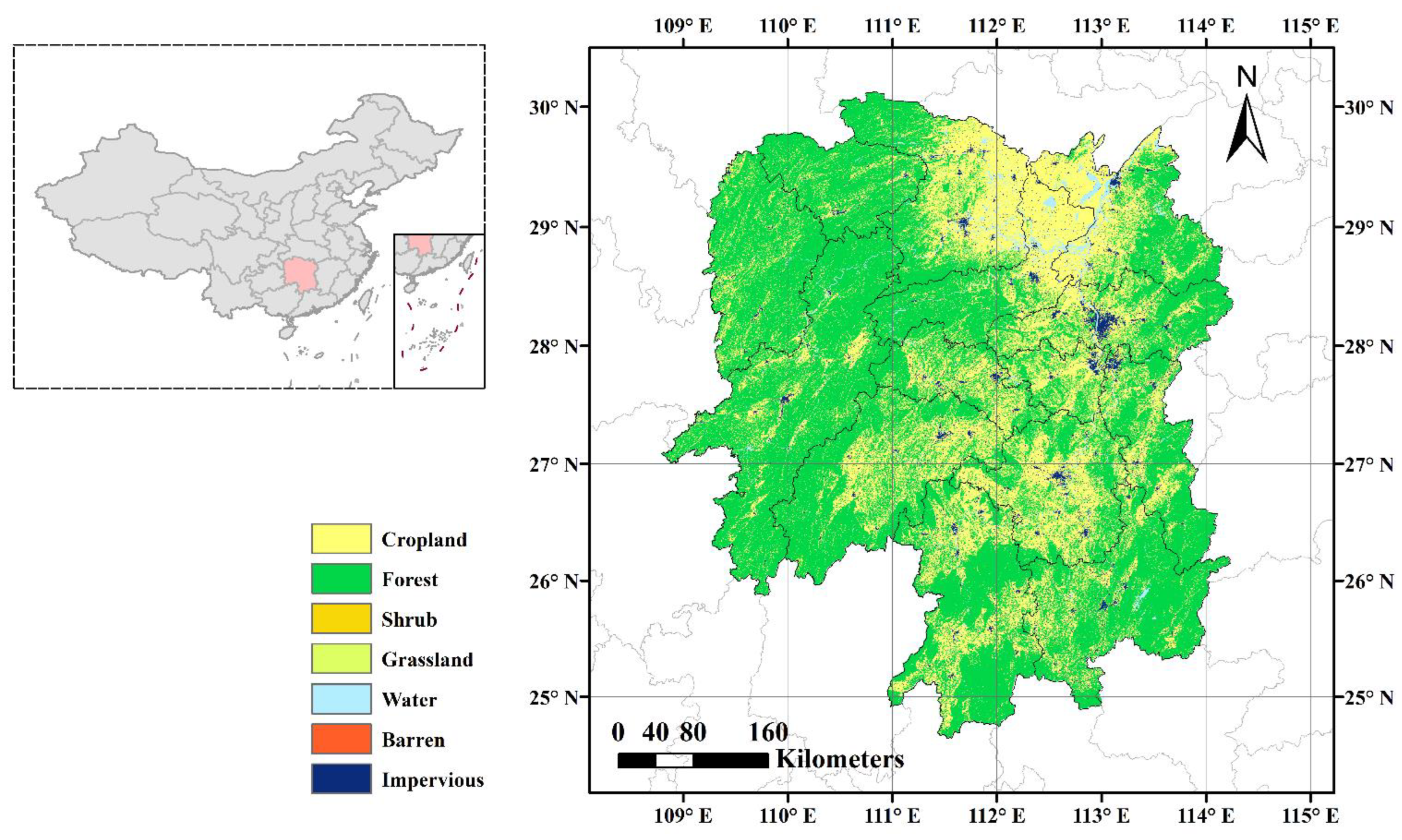
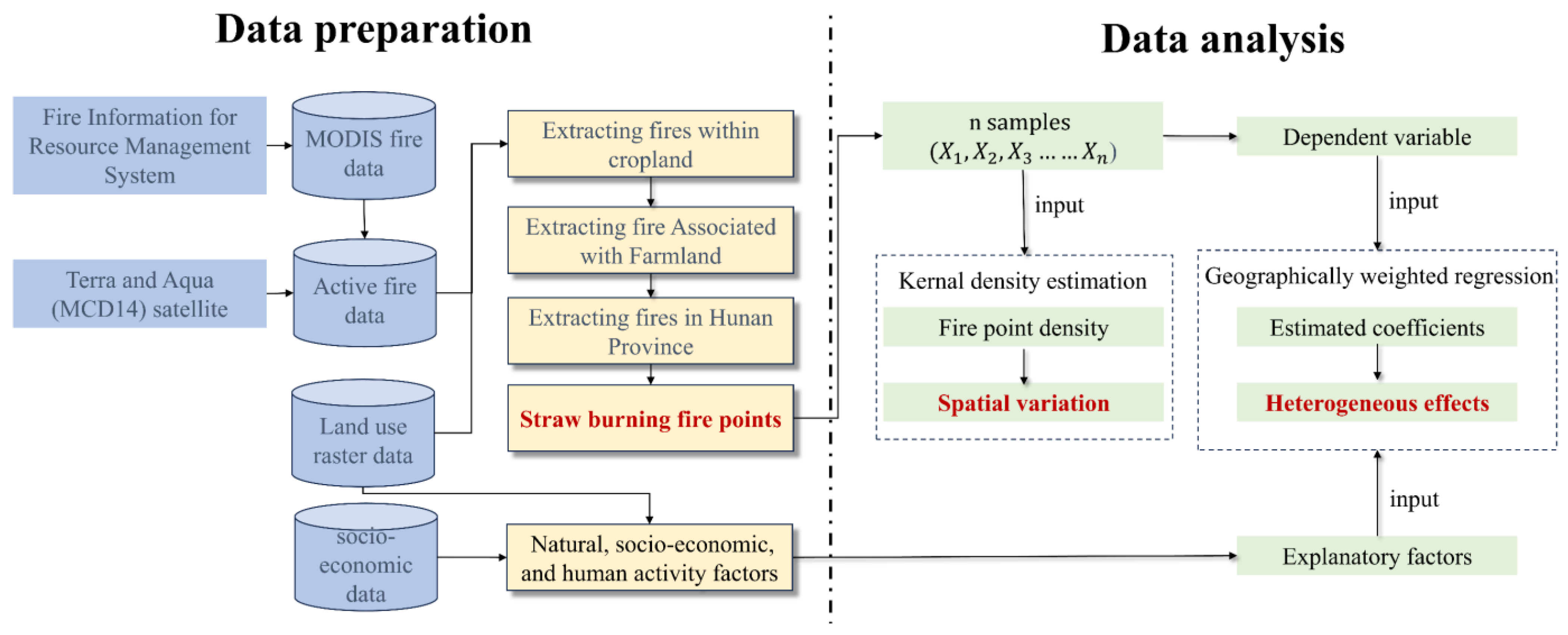
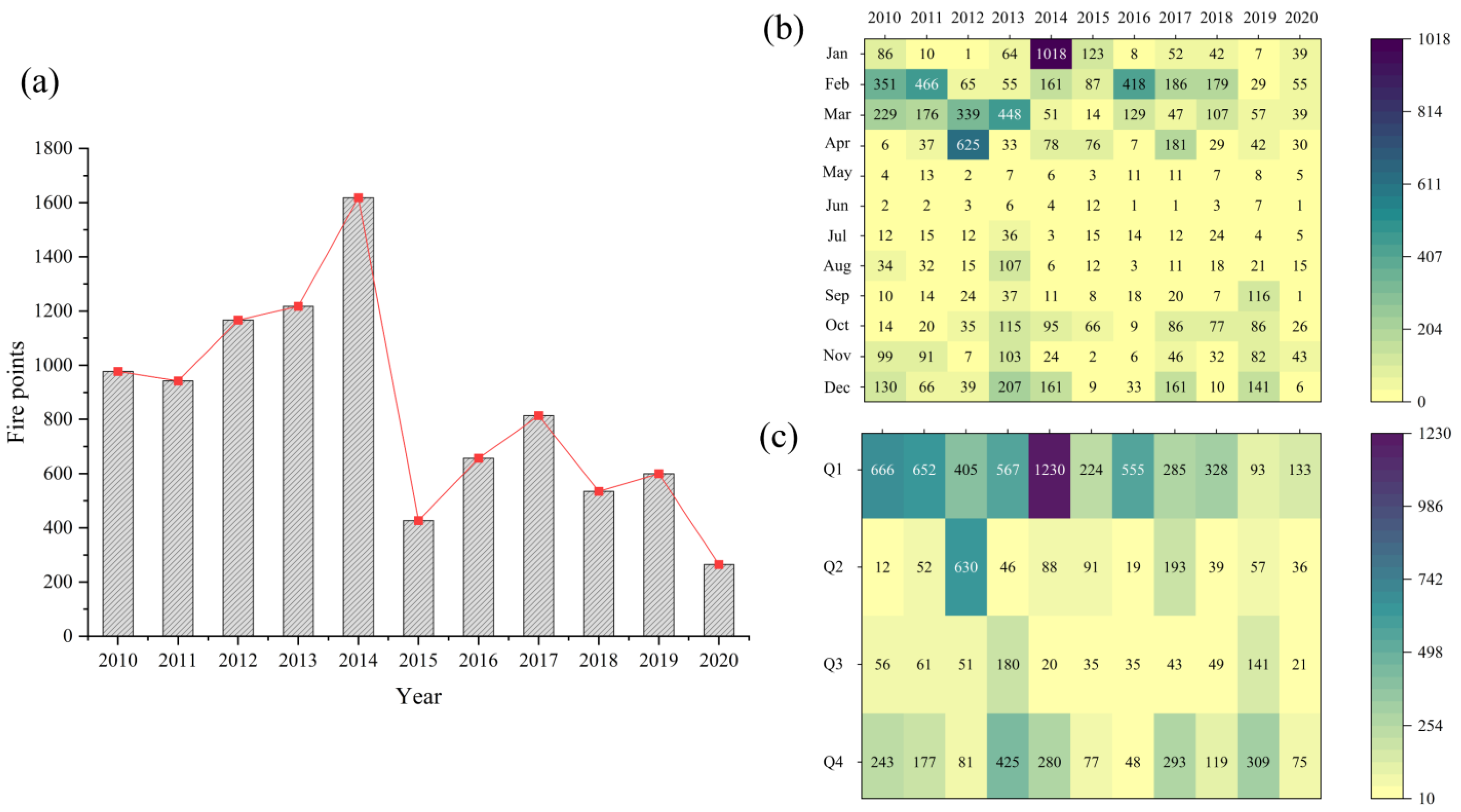

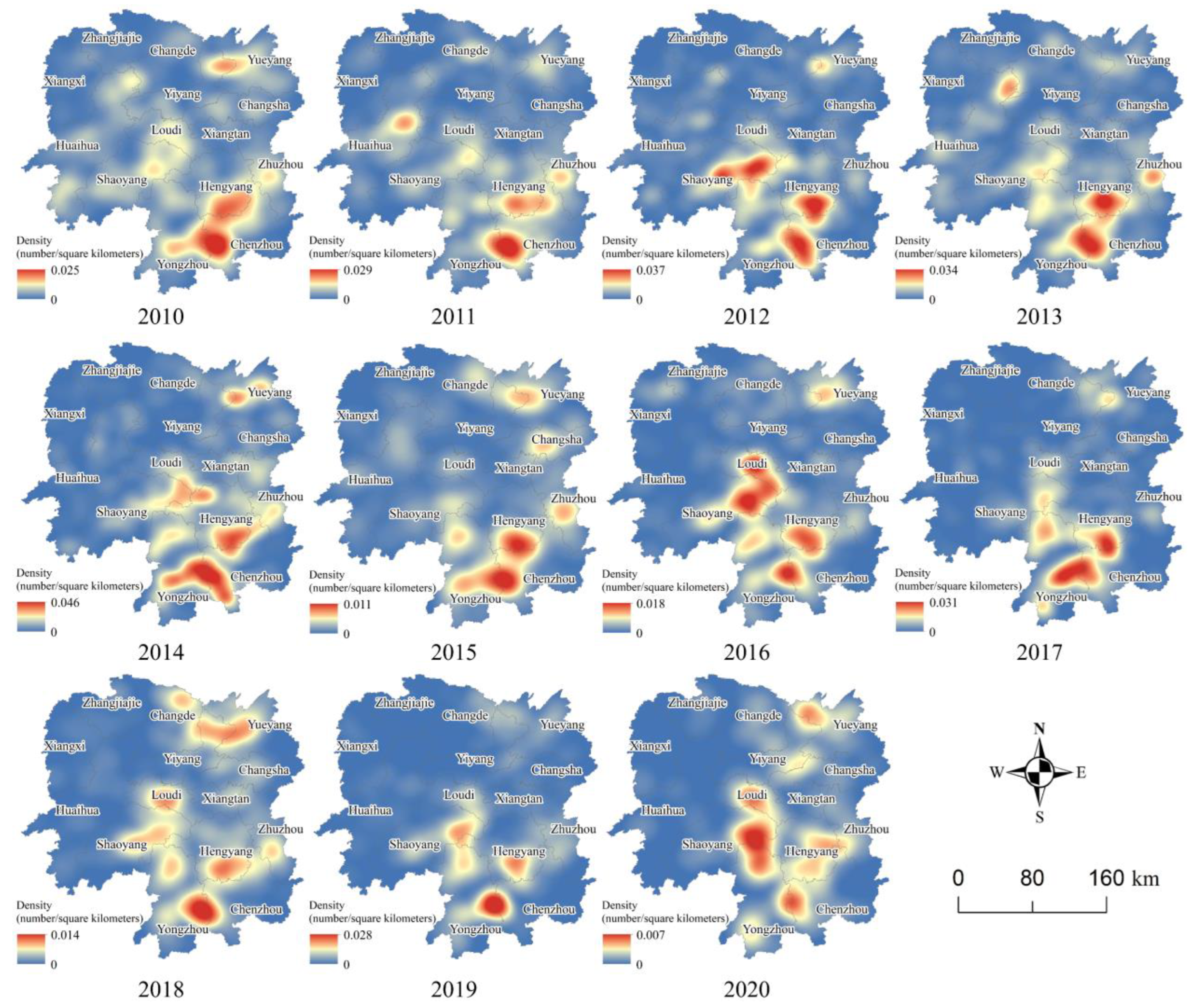
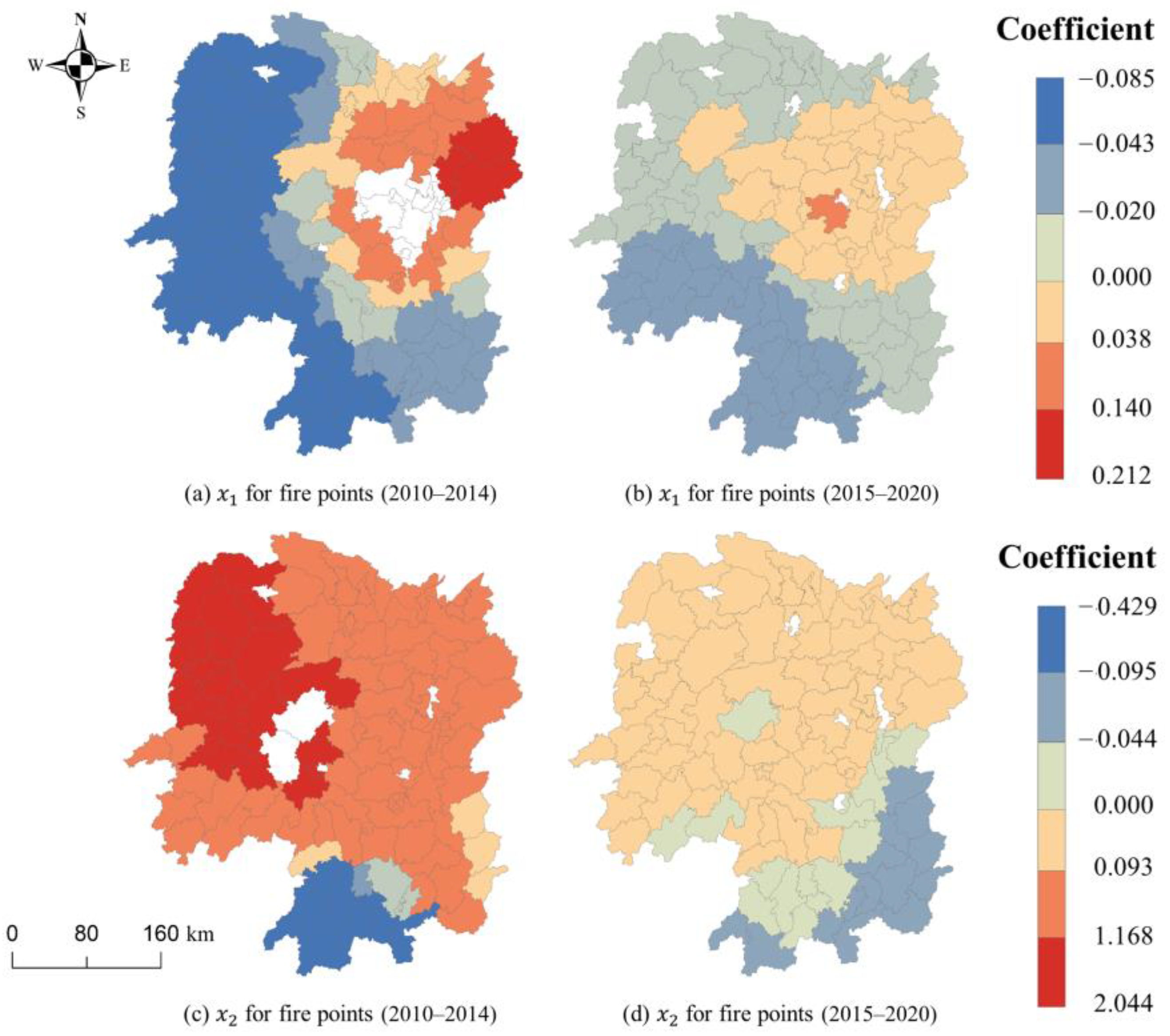
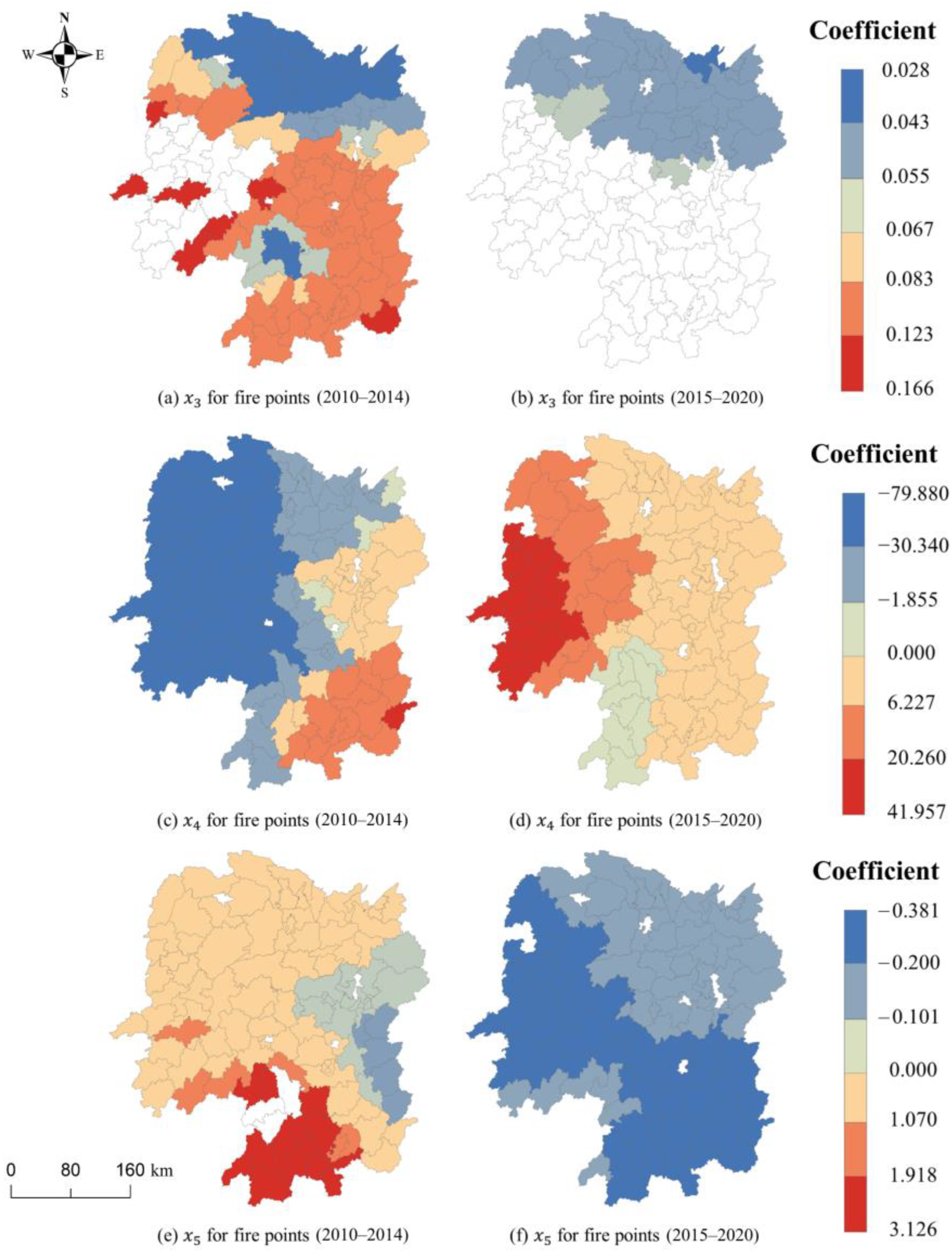
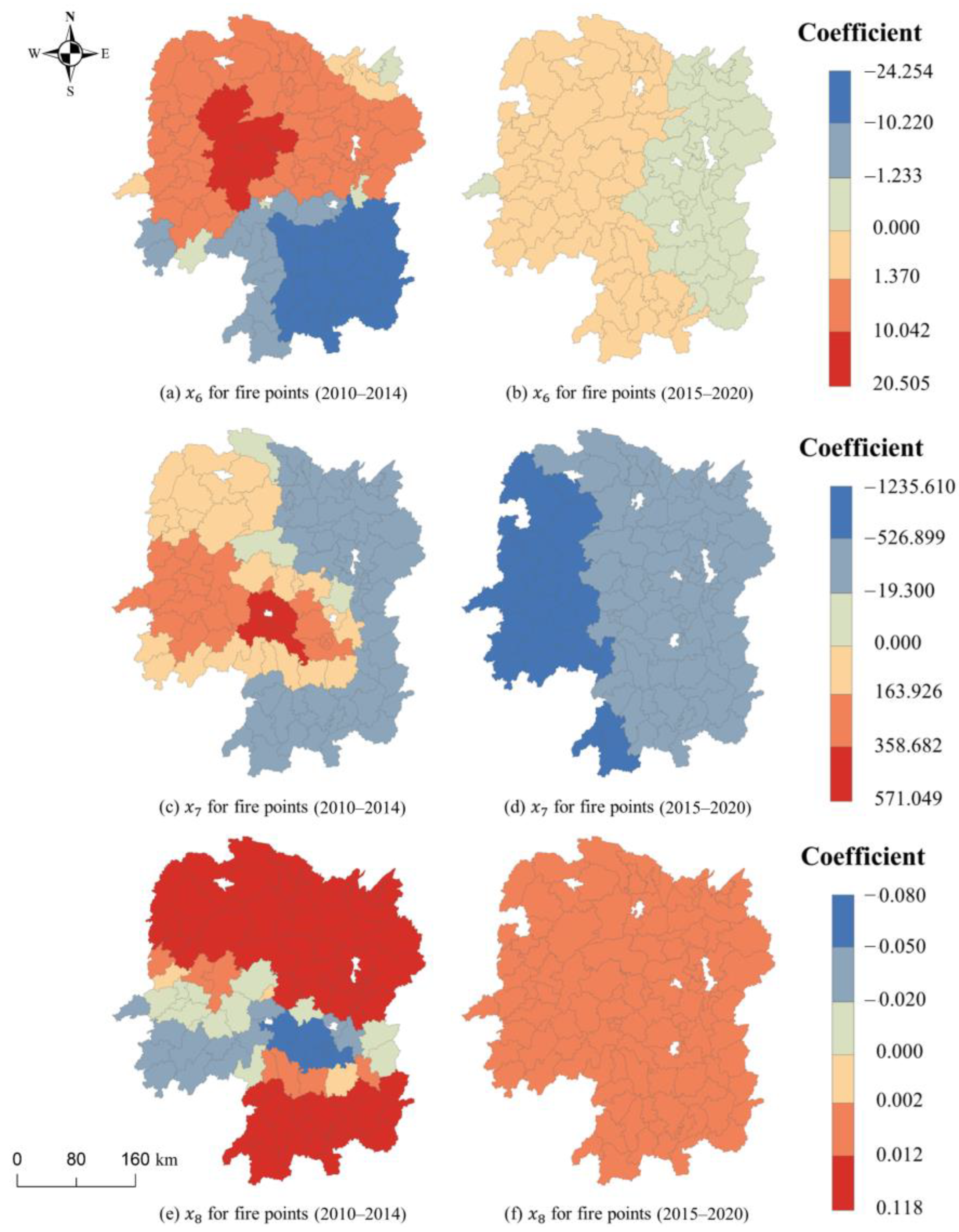
| Data Type | Source | Description | Usage | Resolution |
|---|---|---|---|---|
| MODIS | NASA LAADS DAAC (https://www.earthdata.nasa.gov/eosdis/daacs/laads) (accessed on 1 April 2023) | MOD14 (Terra)/MYD14 (Aqua) | Extracting the number of fire points | 1 km × 1 km |
| Land-use and administrative area | Resource and Environmental Science and Data Center, Chinese Academy of Sciences (https://www.resdc.cn/) (accessed on 1 April 2023) | Land-use data in 2010, 2014, and 2020 | Extracting the number of fire points | 1 km raster data 30 km × 30 km |
| Digital Elevation Model (DEM) | Geospatial Data Cloud (http://www.gscloud.cn/search) (accessed on 1 April 2023) | SRTM DEM | Extracting natural factors, including elevation, slope, and aspect | 90 m |
| Crop information | Hunan Statistical Yearbook (2010–2020) | Annual crop yield and crop-sown area of various districts or counties in Hunan Province | Extracting Socioeconomic factors, including crop yield and crop-sown area | / |
| GDP and population density | Hunan Statistical Yearbook (2010–2020) | Annual GDP and population of various districts or counties in Hunan Province | Extracting Socioeconomic factors, including GDP and population density | / |
| Roads and settlements | National Catalogue Service for Geographic Information (https://mulu.tianditu.gov.cn/main.do?method=index) (accessed on 1 April 2023) | Public basic geographic information data in 2014 and 2019, respectively | Extracting human activity factors, including road density, settlement density, and distance from road | / |
| Variable | Description | 2010–2014 (116 Districts) | 2015–2020 (111 Districts) | ||
|---|---|---|---|---|---|
| Mean | St. Dev. | Mean | St. Dev. | ||
| Dependent variable | |||||
| Fire points | Number of fire points | 54.7 | 59.7 | 31.7 | 29.4 |
| Natural factors | |||||
| Elevation | Elevation of administrative districts (m) | 383.4 | 261.3 | 396.3 | 258.9 |
| Slope | Slope of administrative districts | 2.5 | 1.7 | 2.6 | 1.7 |
| Aspect | Aspect of administrative districts (sine) | −0.02 | −0.67 | −0.01 | 0.68 |
| Socioeconomic factors | |||||
| Crop yield | Crop yield in districts (kiloton) | 270.7 | 204.0 | 271.3 | 188.5 |
| Crop-sown area | Crop-sown area in districts (km2) | 78.1 | 54.8 | 75.4 | 48.6 |
| Population density | Number of populations divided by the areas of districts (thousands/km2) | 0.5 | 0.6 | 0.5 | 0.6 |
| GDP | Gross Domestic Product of districts (billion) | 18.8 | 19.0 | 28.3 | 26.1 |
| Human activity factors | |||||
| Road density | Total road length divided by the areas of districts (100 m/km2) | 7.8 | 1.7 | 8.0 | 2.3 |
| Settlement density | Number of settlements divided by the areas of districts (counts/km2) | 0.2 | 0.1 | 0.3 | 0.1 |
| Distance from road | Average distance from fire points to the nearest roads in districts (m) | 531.8 | 283.4 | 1563.1 | 709.7 |
| Model 1 (2010–2014) | Model 2 (2015–2020) | |
|---|---|---|
| Elevation | −109.65 | −0.673 |
| Aspect | −1.103 | −30.109 |
| Crop yield | −46.218 | −1.407 |
| Population density | −0.037 | −0.355 |
| GDP | −1.796 | −1.226 |
| Road density | −259.450 | −1.230 |
| Settlement density | −7.827 | −0.383 |
| Distance from road | −3.270 | −2.271 |
| Model 1 (2010–2014) | Model 2 (2015–2020) | |||
|---|---|---|---|---|
| AICc | R2 | AICc | R2 | |
| OLS | 1276.259 | 0.184 | 1055.406 | 0.223 |
| GWR | 1247.339 | 0.632 | 1033.696 | 0.505 |
| Variable | Model 1 (2010–2014) | Model 2 (2015–2020) | ||||||
|---|---|---|---|---|---|---|---|---|
| Min | Max | Mean | STD | Min | Max | Mean | STD | |
| Intercept | −493.60 | 236.73 | −77.41 | 177.30 | −10.11 | 43.34 | 11.86 | 15.32 |
| Geographic factors | ||||||||
| ) | −0.09 | 0.21 | 0.02 | 0.08 | −0.04 | 0.04 | −0.01 | 0.02 |
| ) | −0.43 | 2.04 | 0.59 | 0.56 | −0.09 | 0.09 | 0.01 | 0.04 |
| Socioeconomic factors | ||||||||
| ) | 0.03 | 0.17 | 0.09 | 0.04 | 0.04 | 0.08 | 0.07 | 0.01 |
| ) | −79.88 | 20.26 | −19.28 | 26.29 | −1.85 | 41.96 | 8.17 | 9.77 |
| ) | −0.20 | 3.13 | 0.64 | 0.90 | −0.38 | −0.10 | −0.22 | 0.08 |
| Human activity factors | ||||||||
| ) | −24.25 | 20.50 | −1.20 | 10.19 | −1.23 | 1.37 | 0.09 | 0.74 |
| ) | −526.91 | 571.04 | 23.48 | 197.92 | −1235.61 | −19.30 | −383.19 | 321.35 |
| ) | −0.08 | 0.12 | 0.02 | 0.05 | 0.00 | 0.01 | 0.01 | 0.00 |
Disclaimer/Publisher’s Note: The statements, opinions and data contained in all publications are solely those of the individual author(s) and contributor(s) and not of MDPI and/or the editor(s). MDPI and/or the editor(s) disclaim responsibility for any injury to people or property resulting from any ideas, methods, instructions or products referred to in the content. |
© 2024 by the authors. Licensee MDPI, Basel, Switzerland. This article is an open access article distributed under the terms and conditions of the Creative Commons Attribution (CC BY) license (https://creativecommons.org/licenses/by/4.0/).
Share and Cite
Zeng, Y.; Liu, S.; Huang, S.; Patil, S.D.; Gao, W.; Li, H. Exploring Spatiotemporal Characteristics and Driving Forces of Straw Burning in Hunan Province, China, from 2010 to 2020. Remote Sens. 2024, 16, 1438. https://doi.org/10.3390/rs16081438
Zeng Y, Liu S, Huang S, Patil SD, Gao W, Li H. Exploring Spatiotemporal Characteristics and Driving Forces of Straw Burning in Hunan Province, China, from 2010 to 2020. Remote Sensing. 2024; 16(8):1438. https://doi.org/10.3390/rs16081438
Chicago/Turabian StyleZeng, Yu, Shuguang Liu, Sheng Huang, Sopan D. Patil, Wenyuan Gao, and Hao Li. 2024. "Exploring Spatiotemporal Characteristics and Driving Forces of Straw Burning in Hunan Province, China, from 2010 to 2020" Remote Sensing 16, no. 8: 1438. https://doi.org/10.3390/rs16081438






